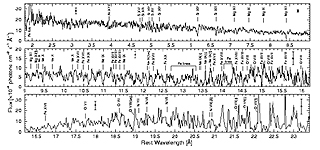May 25, 2000
CXC PR: 00-13
NASA's Chandra X-ray Observatory has examined the stormy environs of a giant black hole in the active galaxy NGC 3783 and measured the dramatic effects of intense radiation produced by matter before it plunges into the black hole. This radiation heats surrounding gas and drives a million mile per hour wind away from the crushing grip of the black hole's gravity.

The central bright spot in this image is the Chandra X-ray image of NGC 3783. The long intersecting lines represent dispersed X-ray spectra, or rainbows, produced by the Chandra grating spectrometer. The faint vertical lines are instrumental artifacts.
Jpeg |Tif | PS |
Credit: NASA/PSU
The Chandra image of NGC 3783, an active galaxy with a giant black hole, is a visual representation showcasing a grating image and a spectrum. The background of the grating image is predominantly dark magenta, with subtle variations in shading. Two bright, orange-yellow lines crisscross the image. At the center of the image, there is a bright, circular red-orange source that represents the object. The complex black and white X-ray spectrum shows absorption and emission lines from various elements. The Chandra X-ray Observatory examined the stormy environs of the giant black hole in the active galaxy NGC 3783 and measured the dramatic effects of intense radiation produced by matter before it plunges into the black hole. This radiation heats surrounding gas and drives a million mile per hour wind away from the crushing grip of the black hole's gravity.
A team of researchers used the High Energy Transmission Grating in combination with the CCD X-ray camera aboard Chandra to study the properties of the wind. "X-ray observations allow astronomers to probe these extremely powerful gas flows that have been suspected to exist, but have been impossible to study precisely before," said Professor Niel Brandt, of Penn State University, University Park, one of the leaders of the team.
The grating spreads the incident X-ray beam into a rainbow-like display of hundreds of different X-ray "colors" or energies. Computers translated this display into a jagged-line plot that resembles an electrocardiogram. Specific elements reveal their presence by sharp absorption dips in the plot. By examining the widths and locations of these dips, the researchers can use the same principle used by a radar gun to measure velocities in the extreme environment of the galaxy's core.
"This is the most detailed X-ray spectrum ever taken of a galaxy with an active black hole," said Dr. Shai Kaspi, also of Penn State. "It reveals that the wind contains oxygen, neon, magnesium, silicon, sulfur, argon, and iron." An analysis of the wind by team member Professor Hagai Netzer of Tel-Aviv University in Israel, showed that the wind almost completely surrounds the black hole.

X-ray spectrum showing absorption and emission lines from various elements.
Jpeg |Tif | PS |
Powerpoint and PDF
Credit: NASA/PSU
The event horizon of the central black hole in NGC 3783 has a diameter about a hundred times that of the Sun, but it produces more radiation than a billion suns as gas is sucked into the black hole at nearly the speed of light. A portion of this powerful radiation is absorbed by gas that surrounds the black hole. Electrons in the gas are boosted from low to high-energy states, and some are ripped from their atoms. The gas is heated to a hundred thousand degrees Celsius or more and driven away from the black hole into the galaxy.
The research team for this investigation also includes Dr. Rita Sambruna, Dr. George Chartas, Professor Gordon Garmire, and Professor John Nousek of Penn State. The High Energy Transmission Grating Spectrometer was built by the Massachusetts Institute of Technology (MIT), Cambridge, MA. The Advanced CCD X-ray Spectrometer (ACIS) X-ray camera was developed for NASA by Penn State and MIT.
NASA's Marshall Space Flight Center in Huntsville, Alabama, manages the Chandra program. TRW, Inc., Redondo Beach, California, is the prime contractor for the spacecraft. The Smithsonian's Chandra X-ray Center controls science and flight operations from Cambridge, Massachusetts.
Images associated with this release are available on the World Wide Web at
AND
http://www.astro.psu.edu/users/niel/papers/papers.html
MEDIA CONTACTS
Steve Roy
Marshall Space Flight Center, Huntsville, AL
Phone: 256-544-6535
Barbara Kennedy
Penn State PIO, University Park, PA.
Phone: 814-863-4682
Dr. Wallace Tucker
Chandra X-ray Observatory Center, CfA, Cambridge, MA
Phone: 617-496-7998


